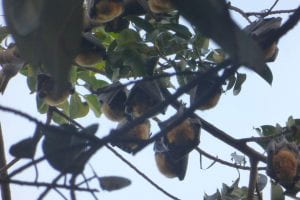With Halloween only two days away, I thought we should turn our attentions to an animal which has become synonymous with the holiday. The word ‘Halloween’ conjures up a series of distinctive shapes in our minds; a pumpkin, a ghost, the far too early Christmas tree in the shops, and the silhouette of a flying bat. But how long could it have been this way? Would a bat have been a symbol of Halloween in the Mesozoic (if dinosaurs had been capable of celebrating this autumnal festival or been dextrous enough to craft decorations to mark it)?

The short answer is no. One of the scariest things to a palaeontologist about bats is their relative rarity in the fossil record. But that isn’t to say we have none. The oldest fossils we do have can be dated to about 52 million years ago; well over ten million years after the extinction of the dinosaurs, during a time known as the Eocene.
When you think about it, there are pretty good reasons for this absence. Bats are small and really quite fragile animals. Having evolved for the air, everything about them is lightweight, their wings, bodies, and bones, all small. It’s little wonder that few survive the millions of years it takes to become a good fossil without being damaged beyond recognition or destroyed altogether.

This lack of information is pretty infuriating to a palaeontologist for two main reasons. Bats, or Chiroptera to give them their proper name, are the most diverse group of living mammals, accounting for a staggering 20% of all mammal species. They are the only group of mammals to ever have evolved powered flight in fact, and fossils could shed light on how and when this came to be.
The other reason is that bats have a pretty special set of characteristics. That distinctive wing structure and ability to echolocate are fascinating traits, ones which could have a rich and interesting evolutionary history. Annoyingly though, as is the case for many animals, the part of them we most commonly find fossilised are their teeth; great for telling us all about their diets, but not so much how they flew, or didn’t fly as the case may be.
Anyone who has seen a bat up close knows that, for the most part, they are actually somewhat adorable. Their fluffy, shrew-like faces being more a thing of cuteness than horror. However, if you actually stop and think about what exactly is going on to make a bat wing, you might realise how this eerie reputation got started.
Bat wings are an excellent example of the scientific principle of homology; evolution displaying remarkable variation in form when using the same limited components. The bones in a bat’s wings are the same as those that make up our arms; the difference is all in the proportions and what they’ve evolved to do.
Their wings are pretty much nothing more than hands that have been expanded to an almost cartoonish degree. From digits 2 to 5, their metacarpals stretch from longer than their humerus, and their phalanges (finger bones) aren’t exactly short either. Connecting their fingers is a thin membrane of skin, called the patagium, which acts as the wing surface. Much like the wing of the ancient pterosaurs, this membrane then connects to the ankle of the animal, forming a huge surface to maximise lift.

Bats look so elegant in flight, but the truth is that they are actually just enthusiastically clapping the air, trying to stay aloft with vigorous jazz hands. They don’t seem quite as spooky in that context do they?
Without fossils to illustrate how these clown-handed shrews came to be scientists have to rely on other studies, such as molecular analysis. One of the most important things concluded from this work is that bats are a monophyletic group, meaning that every living bat today can trace their family histories back to the same ancestors. That wing and echolocation combo truly is unique, and has not evolved more than once.
Further to this, this technique can be used to give an approximate date of when bats first evolved. Findings confirm what the fossil record suggest, that no bat, vampiric or otherwise, would have been able to spook a dinosaur, only originating 63 million years ago. But that does still leave a tantalising gap of 10 million years where we know bats must have been evolving, but we have yet to find any fossils of them.
The closest thing dinosaurs had to a bat would have been early gliding mammals like Volaticotherium in the Jurassic period. But it was far closer to an insectivorous flying squirrel than a bat. There’s only one known fossil of this animal, the earliest known gliding mammal, so it’s hard to say much about it. However, it certainly wasn’t capable of powered flight.
However, there was another animal living in the Mesozoic even more bat-like. But it wasn’t a mammal at all, this wasn’t a creature living alongside the dinosaurs, this animal was a dinosaur. That though, is a story for another time, and will be the focus of a future blog post.

As far as we are concerned today, it stands that the oldest bat-line animal we know of is a little 40-gram specimen called Onychonycteris from the Wyoming of 52.5 million years ago. Far from a perfect bat, reconstructions suggest that this mammal was nowhere near as aerodynamically specialised as its modern relatives. Somewhat to be expected from an animal only just making the leap from gliding to powered flight.
Forget myths of vampires or realities of the ease of disease transmission, it’s the thoughts of the sparse fossil record of bats that keep palaeontologists up at night, and is undoubtedly the reason we still hang bat décor at this time of year.
Rhys Charles is the Engagement Officer for the Earth Sciences department of the University of Bristol, and has headed the Bristol Dinosaur Project since 2016. (@tweetodontosaur)
Article edited by Kim Chandler
References
Simmons, N. B. & Cirranello, A. L. (2019) Bats of the world: A taxonomic and geographic database. http://batnames.org
Lei, M. & Dong, D. (2016) Phylogenomic analysis of bat subordinal relationships based on transciptome data. Scientific Reports. 6: 27726
Meng, J. et al. (2006) A Mesozoic gliding mammal from northeastern China. Nature. 444: 889 – 893
Amador, L. I., Simmons, N. B., & Giannini, N. P. (2019) Aerodynamic reconstruction of the primitive fossil bat Onychonycteris finneyi (Mammalia: Chiroptera) Biology Letters. 15: 3

